Press Releases

04-08-2023 15:15
Census of Population and Housing 2021: Preliminary results by district and municipality/community
The Statistical Service announces the preliminary results of the Census of Population and Housing 2021 by district and municipality/community.
According to the preliminary results, the total population in the Government controlled areas of Cyprus on the 1st October 2021 was 923.272 persons, while the corresponding total number of housing units was 492.555. An increase of 9,9% was recorded in the total population compared to the results of the 2011 Census of Population and Housing (840.407 persons), whereas the percentage increase in the housing units was 13,7% (433.212).
Housing Units and Population by District and Urban/Rural Area
A total number of 163.239 housing units and 350.824 persons were enumerated in the District of Lefkosia, corresponding to 33,1% and 38,0% respectively of the total for Cyprus. In Lemesos District, 132.305 (26,9%) housing units and 262.236 (28,4%) persons were enumerated, in Larnaka District 82.233 (16,7%) housing units and 155.753 (16,9%) persons, in Pafos District 74.498 (15,1%) housing units and 100.175 (10,8%) persons and lastly in Ammochostos District, 40.280 (8,2%) housing units and 54.282 (5,9%) persons.
The diagrams below present the percentage distribution of the housing units and population by district.
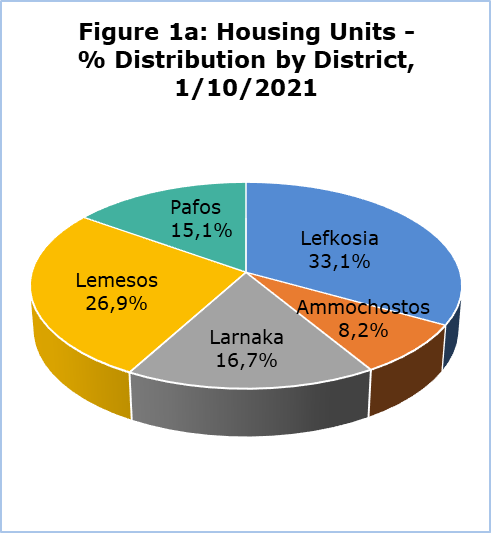
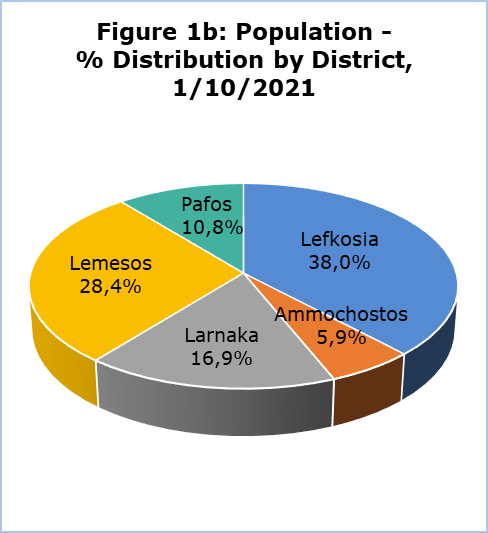
Compared to the results of the 2011 Census of Population and Housing, the largest percentage increase in the number of housing units (18,0%) as well as in the population (16,4%) was recorded in Ammochostos District. The second largest percentage increase in the population was recorded in Pafos District (13,5%), whereas the second largest percentage increase in housing units was recorded in Lemesos District (15,4%).
|
District |
Housing Units |
Population |
||||
|
1/10/2021 |
1/10/2011 |
% Increase 2021/2011 |
1/10/2021 |
1/10/2011 |
% Increase 2021/2011 |
|
|
Lefkosia |
163.239 |
144.556 |
12,9 |
350.824 |
326.980 |
7,3 |
|
Ammochostos |
40.280 |
34.150 |
18,0 |
54.282 |
46.629 |
16,4 |
|
Larnaka |
82.233 |
73.676 |
11,6 |
155.753 |
143.192 |
8,8 |
|
Lemesos |
132.305 |
114.662 |
15,4 |
262.238 |
235.330 |
11,4 |
|
Pafos |
74.498 |
66.168 |
12,6 |
100.175 |
88.276 |
13,5 |
|
Total |
492.555 |
433.212 |
13,7 |
923.272 |
840.407 |
9,9 |
According to the preliminary results of the 2021 Census, 615.731 (66,7%) persons resided in urban areas and 307.541 (33,3%) in rural areas. The corresponding percentages recorded in the 2011 Census were 67,4% (566.191 persons) and 32,6% (274.216 persons), thus showing that overall, there was no reduction in the population of rural areas, even though in some distant or mountainous communities there was a decrease in the number of residents. Furthermore, the total population increase recorded in urban areas compared to the 2011 Census was 8,7% and in rural areas 12,2%. As regards housing units, a share of 60,5% (297.805 housing units) are in urban areas and 39,5% (194.750) in rural areas. Compared to 2011, an increase of 12,8% in the total number of housing units was recorded in urban areas and a corresponding increase of 15,1% in rural areas.
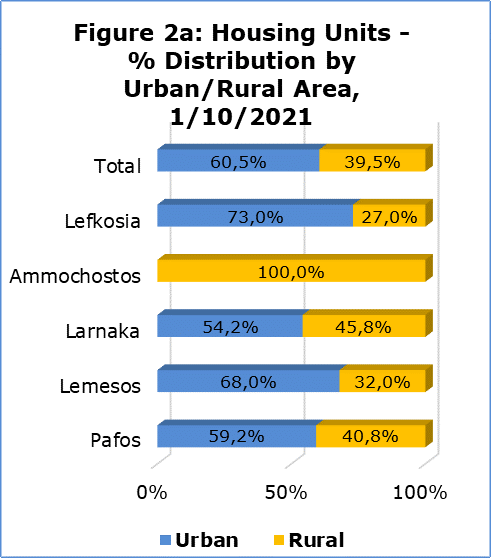
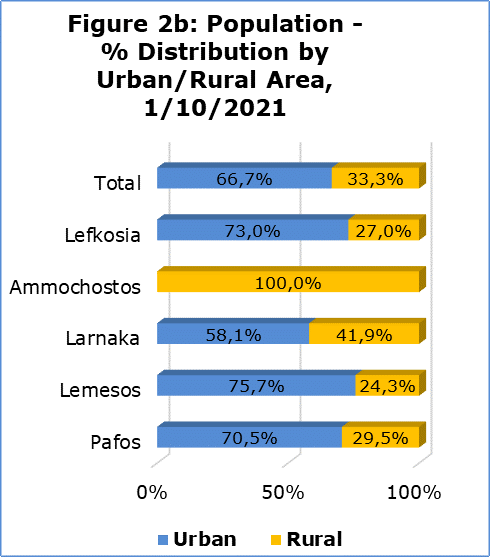
Population and Housing Units by Municipality/Community
Based on the preliminary results of the 2021 Census, the largest municipality in the Government controlled areas is Lemesos Municipality with a total population of 108.105 persons (54,4% of the total population of urban Lemesos) and 50.183 housing units (55,8% of the total housing units in urban Lemesos). It is followed by Strovolos Municipality with a total of 71.123 persons enumerated (27,8% of the total population of urban Lefkosia) and 32.585 housing units (27,3% of the total housing units in urban Lefkosia) and Lefkosia Municipality with 56.848 persons enumerated (22,2% of the total in urban Lefkosia) and 30.145 housing units (25,3% of the total in urban Lefkosia). The same ranking among the three largest municipalities was also been observed in the results of the 2011 Census.
Focusing our attention to the municipalities with a population of 20.000 persons and above (this concerns municipalities only in urban areas), it is evident that in the last decade the largest percentage increase, both in housing units and in population, was documented in the Aradippou Municipality with 19,6% and 19,3% respectively. The second largest percentage increase in the population compared to the 2011 Census was recorded in Egkomi Municipality with 13,8%, followed by Pafos Municipality with 13,4%.
In rural areas, Paralimni Municipality is the largest municipality with 20.450 housing units (+13,3% compared to 2011) and population 19.035 persons (+27,2%), followed by Dali Municipality with 4.391 housing units (+20,9%) and 12.350 persons (+18,0%).
In the last decade, in urban Lefkosia, the municipality with the largest percentage increase both in housing units and population was Geri Municipality with 19,4% and 17,2% respectively (3.644 housing units and 9.651 persons).
In urban Lemesos, the municipality with the largest percentage increase compared to 2011 was Germasogeia Municipality, both in housing units and population, with 35,6% and 29,1% respectively (11.254 housing units and 17.325 persons). A significant increase in urban Lemesos was also recorded in Ypsonas Municipality with a 31,5% increase in housing units and a 25,6% increase in the population (4.968 housing units and 13.966 persons).
In Larnaka District, the largest municipality according to the 2021 Census was Larnaka Municipality with 29.545 housing units and a population of 52.038 persons. Consequently, Larnaka Municipality constitutes 66,3% of the total number of housing units in urban Larnaka and 57,6% of the corresponding population.
Pafos Municipality is the largest municipality in Pafos District, with a total of 24.003 housing units and a population of 37.297 persons, which constitutes 54,4% of the total number of housing units and 52,8% of the total population in urban Pafos.
In Ammochostos District, Paralimni Municipality with 20.450 housing units and 19.035 persons enumerated, constitutes 50,8% of the housing units and 35,1% of the population of the district.
Significant positive changes were recorded in other municipalities and communities in the 2021 Census, such as Pegeia Municipality, Agia Napa Municipality and the communities of Pyla, Voroklini and Chlorakas.
The Statistical Service will be able to provide more detailed information at a later stage. The data which will be produced will be announced and published on the web Portal of the Statistical Service.
The Statistical Service would like to express its sincere appreciation to all citizens for providing the required information and would like to assure them that all data recorded in the questionnaires, as well as the information processed from administrative sources, will be treated as confidential and will be used solely for statistical purposes.
Methodological information
The purpose of the Census of Population and Housing 2021, was the complete and accurate geographical coverage of all housing units, institutions, households and individuals, Cypriot and foreign nationals, who had their usual residence in the Government controlled areas on the 1st of October 2021.
The Census is an important source of information and of statistical data and is usually conducted at regular intervals of 10 years. It is the most costly and demanding project carried out by the Statistical Service. The last Census of Population was conducted in 2011.
The present announcement presents provisional data which may be subject to minimal revisions after the final processing and validation take place, procedures which are necessary for providing high-quality statistical information.
Data Collection Method
According to the original planning, the collection of data would be carried out through personal or telephone interviews (traditional method), with the use of tablets, or with the completion of paper questionnaires by the respondents themselves.
A total of 1.000 enumerators would be responsible for the collection of data in all districts. Due to the fact that there was not enough interest from candidates, a much lower number of enumerators was employed, having a negative impact on the timeframe of the Census. In addition to that, the exceptional conditions and the restrictions that were in place during autumn 2021 due to the coronavirus pandemic (Covid-19) constituted another factor that inhibited the smooth development of the project, thus setting the completion of the Census outside the initially planned deadline (end of December 2021).
In order to complete the project, it was therefore necessary to modify the initial method of data collection. In particular, the new methods adopted involved the use of administrative data as additional sources of information as well as the use of modern technology. The administrative sources used for this purpose, following the approval by the Commissioner for Personal Data Protection, provided information on the main demographic characteristics of the population, such as the place of residence, sex, age, citizenship etc. These sources mainly included the Health Insurance Organisation Beneficiaries data base, the Births Register, the Deaths Register as well as the Population Register.
The preliminary results were obtained both from the collection of data using the traditional method (achieving a coverage of 80% of the population) and from administrative sources (to cover the remaining population). Data collection and data validations will continue to take place, either through personal/telephone interviews or by further processing of the available administrative sources, in order to complete the Census.
The use of administrative sources for the purpose of the Population Census is a methodological approach broadly used in many European countries for some years now. According to the latest information available, a proportion of 38% of EU countries has chosen to conduct the Census of Population 2021 exclusively from administrative sources, whereas an equally significant proportion of countries (35%) has chosen to use both the traditional Census and the use of administrative sources (combined Census). The traditional method of data collection with interviews is still used by 27% of EU countries.
The aim is that the framework that will result from the Census of Population will constitute a Dynamic Statistical Population Register which will be updated on an ongoing basis from various administrative sources. As a result, it will no longer be necessary to conduct a door-to-door Population Census, covering the total population. The Dynamic Statistical Population Register will be the basis for the production of annual population data and demographic indicators, providing timely information that will facilitate state policy and planning.
Legal Framework and Data Protection
The Census of Population 2021 was conducted in all EU Member States, following common concepts and definitions, under Regulation (EC) No. 763/2008 of the European Parliament and of the Council of 9 July 2008 on population and housing censuses.
The Census in Cyprus was also conducted in accordance to the Official Statistics Law of 2021 (Law No. 25(Ι)/2021). Based on the provisions of the Law, the data collected are treated as confidential and are used solely for statistical purposes.
Statistical confidentiality is strictly applied by the Statistical Service. The internal procedures resulting from the application of statistical confidentiality, fully cover the provisions of the General Data Protection Regulation (EU) 2016/679 (GDPR), ensuring the protection of data at every stage, from collection to publication. All data collected will be aggregated and disseminated without directly or indirectly revealing the identity of the persons who provided the data.
For further information, visit the CYSTAT Portal, subtheme Population, CYSTAT-DB (Online Database), Predefined Tables (Excel) or contact Ms Loukia Makri at tel. 22602150 or email lmakri@cystat.mof.gov.cy, or Ms Koulia Onisiforou tel. 22602139 or email konisiforou@cystat.mof.gov.cy.
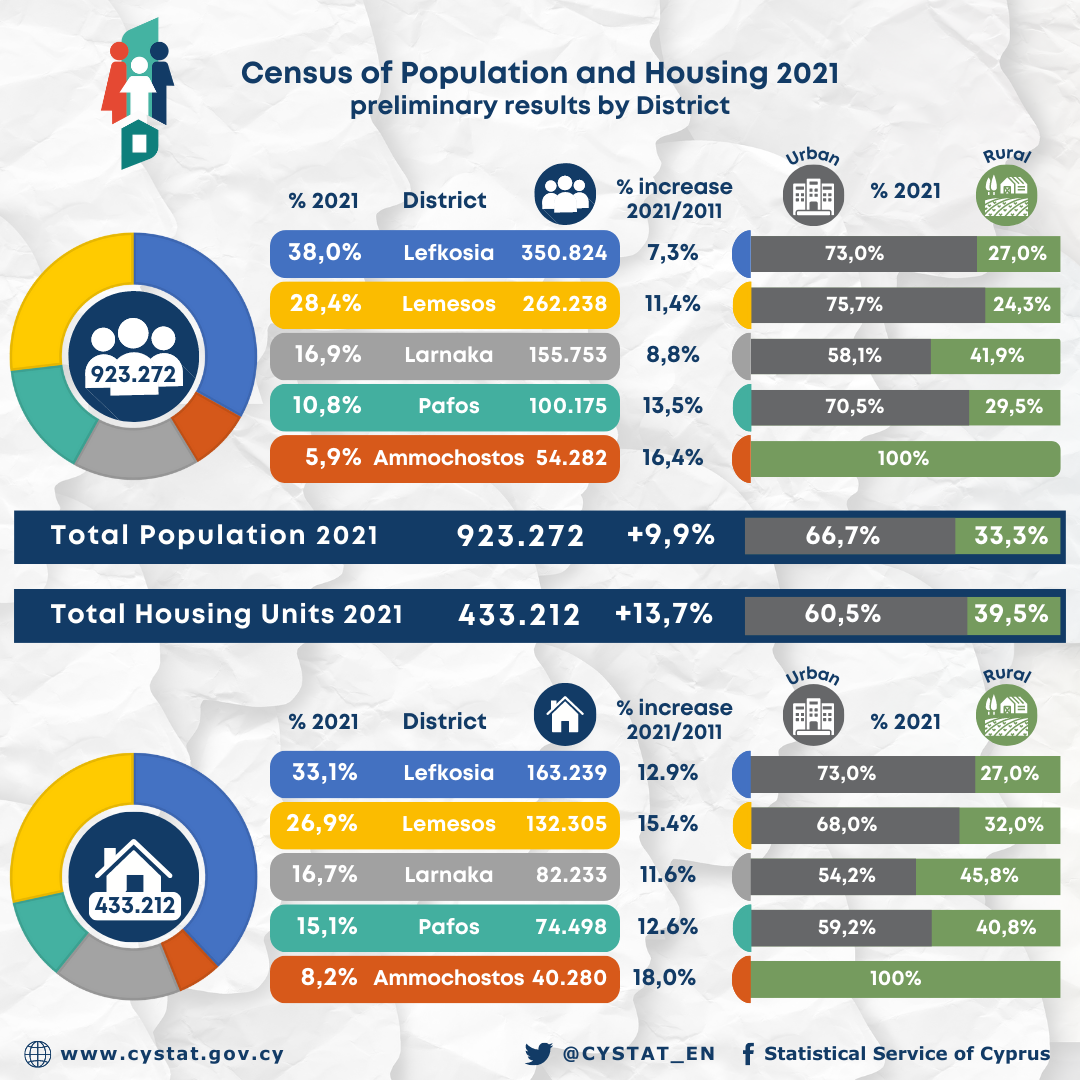
(MV/SCH)
Relevant Press Releases



18-11-2024 14:15
Price Index of Construction Materials: October 2024

15-11-2024 15:12
Road Freight Transport: 2nd Quarter 2024

14-11-2024 13:52
GDP Growth Rate: 3rd quarter 2024 (Flash Estimate)


